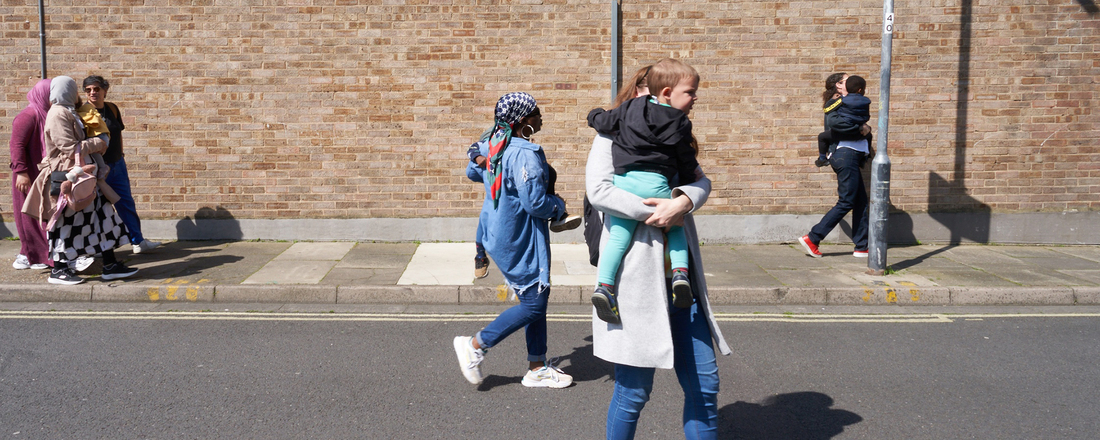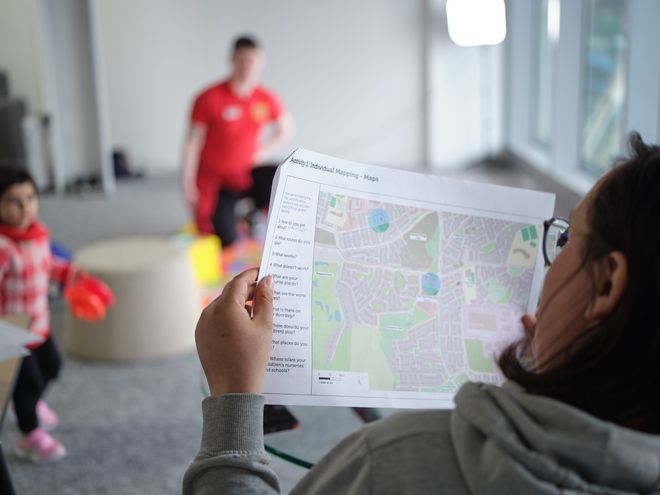Get updates from The Developer straight to your inbox Yes, please!
Caregivers and young children rarely consulted in community engagement despite representing a third of the population
The creation of the Family Voices Toolkit seeks to redress a lack of engagement with caregivers and young children. Harriet Saddington reports on the free-to-download engagement tool that contains everything you need to host a session
W here and how a child lives deeply affects their outcomes in later life. These economic, learning, social and health consequences have ripple effects for wider society. Likewise, the wellbeing of the parent or caregiver directly influences a child’s development. We know that poor housing can lead to financial and mental stress, as well as strain on physical health.
Yet the family unit is routinely unrepresented in discussions around how homes might be designed to meet their needs, improve their wellbeing and strengthen their social network.
The creation of the Family Voices Toolkit seeks to redress this lack of engagement with caregivers and young children. Its recent launch at the Earls Court development in London on 12 November brought together impact investors, developers, design teams, think-tanks, housing associations, academics and policy makers – and the momentum was palpable. Created by the Van Leer Foundation and ZCD Architects, the toolkit is available for all, and free to download with everything you need to begin hosting engagement sessions with caregivers and young children.
“There’s a perception that finding this group and speaking and listening to them is hard,” says Irina Ivan-van der Kwaak from the Van Leer Foundation. “The toolkit has made this process easy”
The Van Leer Foundation is a Dutch organisation and endowment fund dedicated to supporting young children, caregivers and communities. Over its 75-year history it has invested in projects focused on early childhood in over 60 countries. A flagship initiative of the foundation is its global Urban95 programme (95cm being the average height of a healthy three-year-old) which supports city leaders, designers and other urban professionals to view their cities from 95cm and ask themselves what would they change.

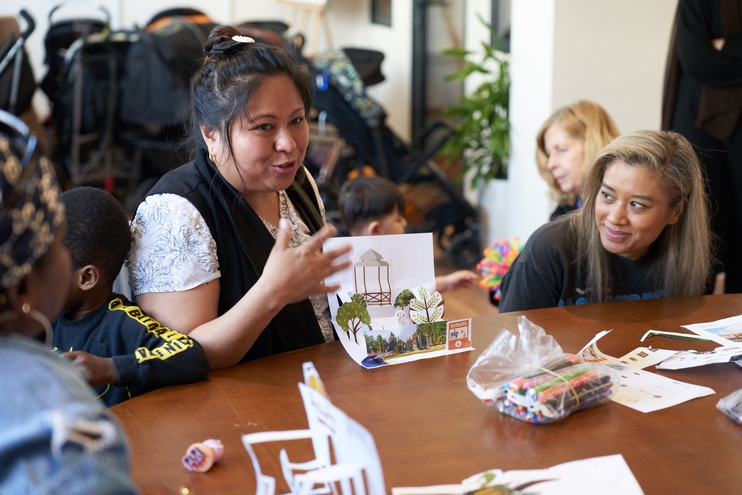
The foundation has also partnered with LSE Cities to run the Urban95 Academy, an executive course open to city officials around the world committed to delivering better cities for babies, toddlers and caregivers. This work has ignited interest but also put a spotlight on the importance of urban environments and particularly housing on the healthy development of children and the wellbeing of caregivers.
Children spend 85 per cent of their waking time outside school in their home and local neighbourhood. For toddlers and their caregivers the number is even greater. In London, more than a third of children are living in poverty and more than two million children in the UK live in overcrowded homes. Children under six and their primary caregiver can make up 20-to-35 per cent of city populations (both in the UK and worldwide).
Parents and caregivers of young children are often busy, isolated, and house-bound. They don’t attend consultations around developments. Evenings are spent getting children to bed. Nor do they typically join a tenant’s group to lobby for their needs. Maybe they wonder what difference it could make.
“This will pay us back tenfold,” says Lori Stanlick, director of social impact for Jonathan Rose Companies, a developer and operator of 19,000 affordable and mixed-income homes across the USA
So how to intervene and help this group? The Family Voices toolkit helps reach and involve families in the planning, design and management of family housing and is already having an impact in the international communities in which it has been piloted.
“This will pay us back tenfold,” says Lori Stanlick, director of social impact for Jonathan Rose Companies, a developer and operator of 19,000 affordable and mixed-income homes across the USA. “I would never have thought to ask these focused questions. They’re going to unlock something for the rest of the community”.
Jonathan Rose ran Family Voices Toolkit sessions in Chicago, facilitated by ZCD, in developments that already exist. Other impact investors and developers have also opted to test the family voices approach in their developments, opening their portfolios for the toolkit – from PATRIZIA Sustainable Communities Fund Global Partners in Ireland, to Bridges Fund Management in Croydon, to Earls Court Development Company in London.
Affordable and social housing is a natural fit for impact investment, which seeks a financial return while making a positive contribution. With a supply/demand imbalance in affordable and social housing across Europe, impact investment funds are increasingly interested in using their capital where it can make a difference and government can’t plug the gap alone.
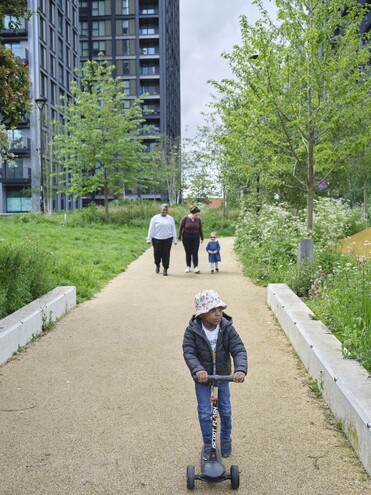
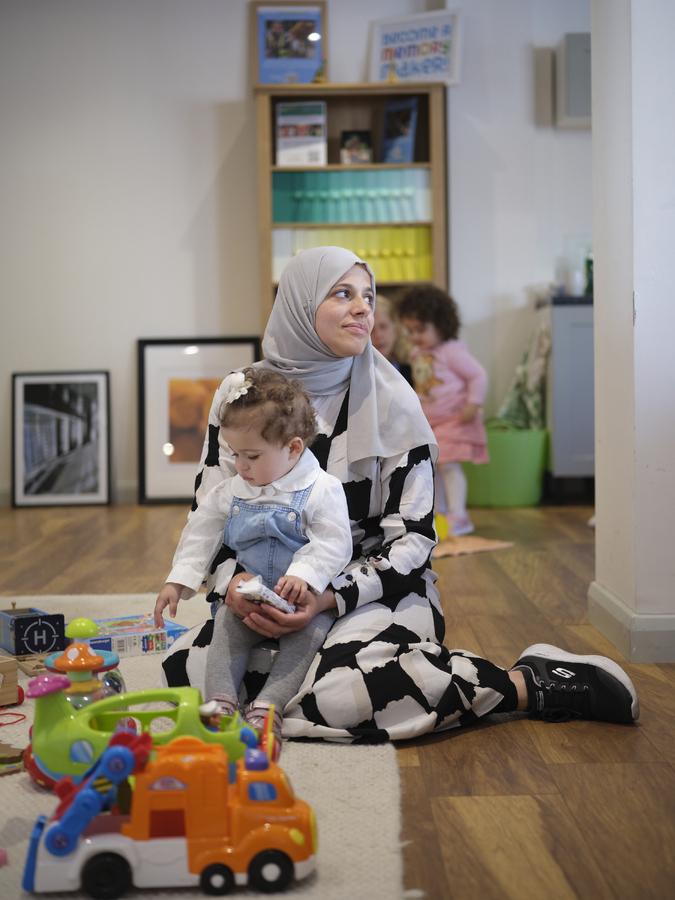
Investment risk is mitigated by ensuring housing and the built environment meets community need. If it does, the positive cycle of a thriving community means lower vacancy rates or demands for further adjustment. Such long-term thinking suits the relative longevity of these 10-year-horizon funds.
“Making a place from a socially responsible perspective is not at odds with investment success,” says Rebekah Paczek, director of public affairs, social impact and community relations at the Earls Court Development Company. “You can make great places with better long-term outcomes for investors as well, by getting people involved in the process.”
From conversations between Van Leer and PATRIZIA, it emerged that there was no readily available pathway to reaching those in need (parents and caregivers) within affordable and social housing. Enter Dinah Bornat of ZCD Architects, whose work is rooted in better engaging with young people and intergenerational groups. “Trust begins in small focus groups,” says Bornat, and this approach underpins what Family Voices does.
This toolkit is different from typical engagement. It is about depth over breadth, quality over quantity. It does not entail a multiple-choice questionnaire or a presentation of precedent images. It establishes how to find people and then have trusted, thoughtful conversations about what really matters. This includes everything from the home’s layout, spaces between buildings, places where people meet, how to get around, where front doors are, the relationship between inside and outside, and proximity of services.
“Trust begins in small focus groups,” says Bornat, and this approach underpins what Family Voices does
The process is applicable to existing communities, new housing developments, or even specific design projects such as a community centre or park. It comprises five sessions to pick and choose from, which can be run singly or in any order. Each session is underpinned by a creative task such as mapping or collage to spark conversation and build confidence. “What I enjoyed most was working together and having people listen to me,” says one participant from Chicago’s Barbara Jean Wright Court apartments.
ZCD has distilled years of experience of what works into a simple framework. It advises bringing toys and warm food, finding a familiar space and including a play space on the walkaround. There are templates for flyers, venue checklists and advice such as how to organise childcare in the space. The toolkit offers guidance on how to make the group feel comfortable, structure listening, and record impact. It shows how to feed back findings for use in formal contexts, such as a Statement of Community Involvement in the UK.

“There’s a perception that finding this group and speaking and listening to them is hard,” says Irina Ivan-van der Kwaak from the Van Leer Foundation. “The toolkit has made this process easy. So that it’s not yet another thing on a really growing list that investors and developers have to do.”
Investors are grappling with the “S-factor” in ESG, and how to measure it. “It ultimately comes down to governance,” says Ivan-van der Kwaak. “Either the government is questioning long-term impact from the regulatory side or its the ‘governance’ of the capital that’s coming in. How do you create incentives in the broader system to ensure that stakeholders across the entire governance chain are thinking about long-run outcomes?”
Ivan-van der Kwaak explains how this toolkit unlocks a full spectrum of social value: inviting communities in to engage collectively and share their thoughts and needs can have an immediate impact. After just two sessions, the Chicago pilot described the mothers who met and connected with each other in the engagement sessions as a “mutual-aid” group.
Building connections in the area enables support to be found in their community and in turn builds capacity. Parents realise they don’t need to do everything alone; they can do it together. In the medium term it converts into design changes, whether design of a home or play space. Or, as Ivan-van der Kwaak says: “How close by is childcare? Because it is within a developer’s control to choose to put a childcare provider on the ground floor, instead of another retail unit.”
Long term, this all pushes towards better outcomes for families from a health and social perspective – and an economic one too.
At the Earl’s Court Development, the team realised that, despite an inclusive engagement process, family voices were unrepresented within their intergenerationally focused group or in wider consultation. So they used the toolkit to give a voice to families in the area
Harvard academic Raj Chetty’s work in the US has shown that where a child grows up influences outcomes. But that “where” is not just about location; it is about quality of their home, community network and affordability of services.
In a world of measurement and social-value proxy pound signs, some might be sceptical of the impact that conversations with a (relatively) small group of parents can bring.
But according to Ivan Rodriguez, Sustainability Director at Bridges Fund Management, these conversations can generate incredibly valuable qualitative insights. “It’s very difficult to capture these voices and get the impact that you want from the toolkit unless you have deep conversations,” he says. “This is a way of engaging that is more human. It might not have the statistical significance of a broad consultation but you can actually get deeper insights. It enables us to design and build homes, not simply housing.”
Bridges and developer HUB piloted the Family Voices toolkit in East Croydon at a completed mixed-use development designed by architect AHMM. Here the toolkit took a”post-occupancy” role and, in just two sessions, uncovered ways to improve equipment and safety for residents. A significant byproduct of the process of bringing “end-users” to life during these sessions is that the development and design team go on to have equivalent “family voices” in their heads from the outset when they design other schemes.
“Government can’t address this alone, private investors can’t, developers can’t, so we all need to work together,” says Marleen Bekkers, Investment Director at PATRIZIA
Focused conversations elicit specifics rather than assumptions. “Good housing” is a blanket term but what matters is good for who. Bornat says: “When you’re at home with small kids, things suddenly become really important. Like your relationship with your neighbour, the ventilation, the way the windows are positioned, whether your balcony is safe for your child to go outside if people are smoking below it. These might be things that we just assume are fine in housing – well of course there’s a balcony! – but people tell us: ‘I’m not letting my child out on the balcony’. Have we thought about that?”
Every second during a child’s first years, more than one million neural connections are made in their brain – a speed never repeated. Research now shows that parents’ and caregiver’s brains are changing during this time too. The depressing figure that 75 million people are socially isolated in Europe becomes tangible with human stories from parents about their reasons for feeling lonely – “trapped” in their home, suffering from poor acoustics, outlook or size.
The way housing and public spaces in the neighbourhood are shaped defines interactions or available support, and their sense of belonging. There may be a polluted walk to a play space with no shade or provision for the youngest children, or an unwelcoming, badly lit street along which to push the buggy at night to get a child to sleep. Housing affects everyone’s mental and physical health (think asthma, obesity, heart disease) – child and adult.
“Government can’t address this alone, private investors can’t, developers can’t, so we all need to work together,” says Marleen Bekkers, Investment Director at PATRIZIA.
What barriers could there be to embarking on this sort of engagement? Time, money, lack of facilitation skills? Everyone involved speaks of its value, even across just two sessions. It is not an expensive process but does require thinking and planning to seek out the needs of this specific group.
“Anybody else would do intense focus-group work on their product that they’re about to launch but in our industry we just don’t do it,” says Bornat
Another concern might be that, by focusing on one group, you risk leaving out another – the “what about” problem. But the evidence shows that there is a synergy with what works for families and for others, such as people with a disability or the elderly who share common concerns about limited physical mobility and access to services, all of whom spend more time at home.
Rather than being an academic study, Family Voices is in-action on live projects. At the Earls Court Development, the team realised that, despite an inclusive engagement process, family voices were unrepresented within their intergenerationally focused group or in wider consultation. So they used the toolkit to give a voice to families in the area.
Family Voices now needs to build on being more than just an engagement process. It should be the centrepiece for a wider feedback loop, potentially across both high and low-income countries, about challenges and scalable solutions regarding housing for families.
“Anybody else would do intense focus-group work on their product that they’re about to launch but in our industry we just don’t do it,” says Bornat. “We need to make housing better for kids. Parents know that, government knows that, and yet we are investing nothing in research about what that means and what that looks like. Why are we focusing on planning consent? Why aren’t we focusing on absolutely getting housing right for this generation?”
The Family Voices approach is reminiscent of the saying that “it takes a village to raise a child”. Perhaps the same is true for what it takes to really improve housing and connections for families. This work shows it starts with deep conversations, and listening. To borrow from one developer’s takeaway at the toolkit launch: “Once you hear from families, it will change your practice.”
Find out more Download the Family Voices Toolkit
If you love what we do, support us
If you can, please support journalism on place: Become a member, advertise or sponsor, buy tickets to our events or support us on Patreon. We are grateful to our supporters. Be part of it.
Sign up to our newsletter
Get updates from The Developer straight to your inbox
Thanks to our organisation members
© Festival of Place - Tweak Ltd., 124 City Road, London, EC1V 2NX. Tel: 020 3326 7238
© Festival of Place - Tweak Ltd., 124 City Road, London, EC1V 2NX. Tel: 020 3326 7238
